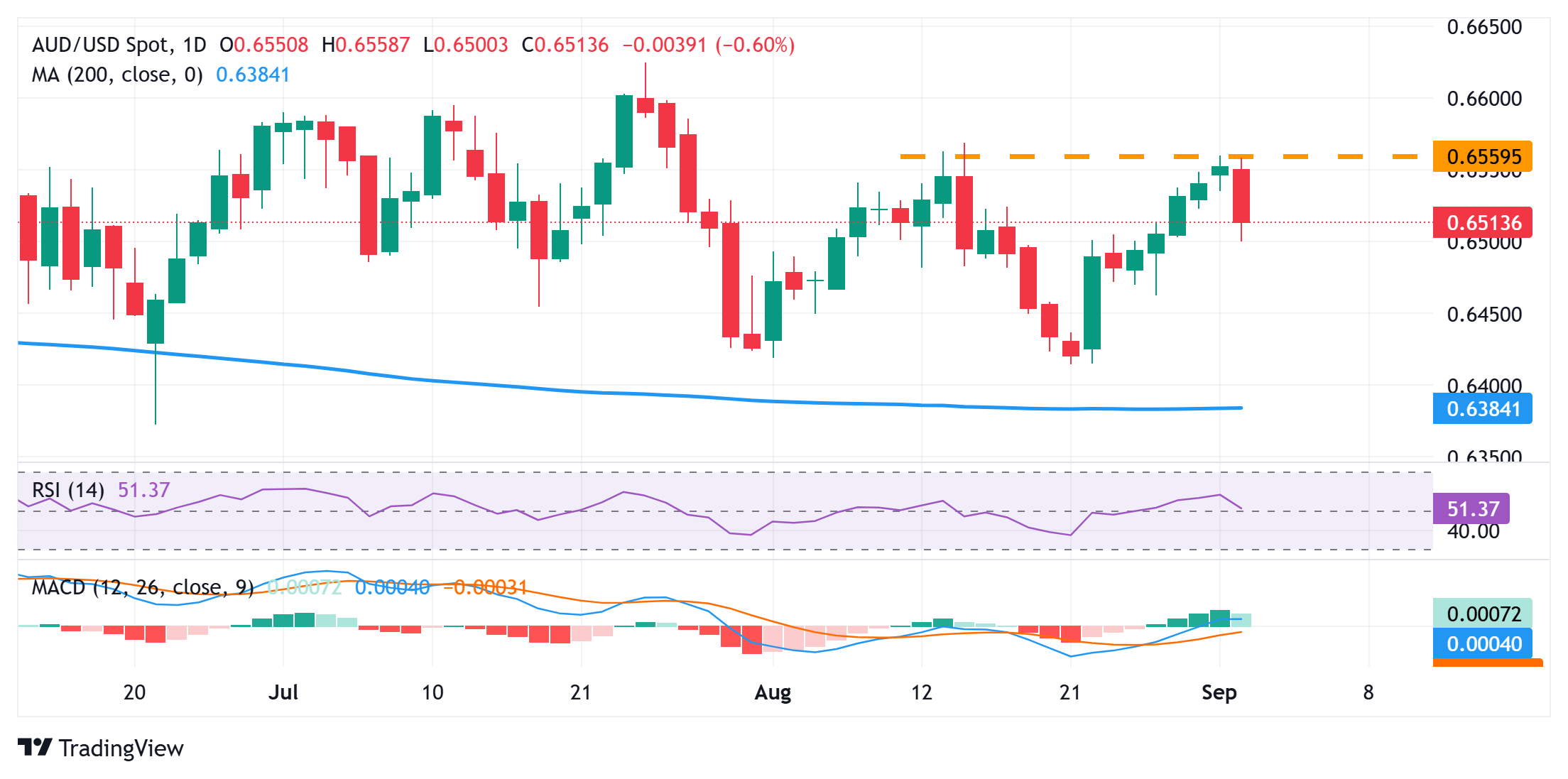
- AUD/USD corrects sharply from a three-week high amid an aggressive USD short-covering rally.
- The meltdown in the global bond markets weighs on the risk sentiment and benefits the buck.
- The RBA’s dovish tilt further undermines the Aussie ahead of this week’s key US macro releases.
The AUD/USD pair attracts heavy intraday selling on Tuesday and reverses a major part of its strong gains registered over the past four days, to a nearly three-week top touched the previous day. The downfall drags spot prices to the 0.6500 psychological mark during the first half of the European session and is sponsored by an aggressive US Dollar (USD) short-covering rally from the vicinity of the August monthly swing low.
Rising fiscal deficits, persistent inflation, and eroding central bank credibility continue to push global bond yields higher, raising concerns about the broader economy. The spillover effect tempers investors’ appetite for riskier assets, which is evident from a turnaround in the risk sentiment and boosts the Greenback. Apart from this, the Reserve Bank of Australia’s (RBA) dovish tilt is seen a another factor weighing on the Aussie.
In fact, the RBA slashed its outlook for economic growth in 2025 to 1.7% from 2.1%, and marginally lowered GDP forecasts for 2026 and 2027, to 2% and 2.1%, respectively. Furthermore, RBA Governor Michele Bullock said that the updated forecasts imply cash rates might need to be lower for price stability and did not rule out back to back rate cuts. Market participants now see a high probability of another rate cut in November.
Moreover, some forecasts extend bets to two or three RBA rate cuts by year-end. The Federal Reserve (Fed) is also anticipated to lower borrowing costs this month and deliver at least two 25 basis points (bps) rate cuts by the end of this year. That said, the incoming US macro data points to a strengthening economy. Moreover, expectations that inflation risk is much higher than recession risk might force the Fed to adopt a less dovish stance.
This, in turn, might now act as a tailwind for the USD and backs the case for a further depreciating move for the AUD/USD pair. Traders, however, might refrain from placing aggressive bets and opt to move to the sidelines ahead of key US macro releases scheduled at the start of a new month, starting with the ISM Manufacturing PMI later this Tuesday. Investors this week will also confront the release of JOLTS Job Openings on Wednesday, the ADP report on private-sector employment and ISM Services PMI on Thursday, and the Nonfarm Payrolls (NFP) report on Friday.
AUD/USD daily chart

Technical Outlook
The recent move up witnessed over the past two weeks or so falters near the 0.6560 horizontal barrier. The said area should now act as a key pivotal point, which, if cleared, should allow the AUD/USD pair to reclaim the 0.6600 mark amid slightly positive oscillators on the daily chart. Some follow-through buying, leading to a subsequent move beyond the year-to-date high, around the 0.6625 region touched in July, will be seen as a fresh trigger for bulls and pave the way for a further near-term appreciating move.
On the flip side, acceptance below the 0.6500 round figure might expose the 0.6420-0.6400 congestion zone, which is followed by a technically significant 200-day Simple Moving Average (SMA), around the 0.6385 region. A convincing break below the latter might shift the bias in favor of bearish traders and cause the AUD/USD pair to accelerate the fall to the 0.6355-0.6350 intermediate support before eventually dropping to test sub-0.6300 levels.
Information on these pages contains forward-looking statements that involve risks and uncertainties. Markets and instruments profiled on this page are for informational purposes only and should not in any way come across as a recommendation to buy or sell in these assets. You should do your own thorough research before making any investment decisions. FXStreet does not in any way guarantee that this information is free from mistakes, errors, or material misstatements. It also does not guarantee that this information is of a timely nature. Investing in Open Markets involves a great deal of risk, including the loss of all or a portion of your investment, as well as emotional distress. All risks, losses and costs associated with investing, including total loss of principal, are your responsibility. The views and opinions expressed in this article are those of the authors and do not necessarily reflect the official policy or position of FXStreet nor its advertisers. The author will not be held responsible for information that is found at the end of links posted on this page.
If not otherwise explicitly mentioned in the body of the article, at the time of writing, the author has no position in any stock mentioned in this article and no business relationship with any company mentioned. The author has not received compensation for writing this article, other than from FXStreet.
FXStreet and the author do not provide personalized recommendations. The author makes no representations as to the accuracy, completeness, or suitability of this information. FXStreet and the author will not be liable for any errors, omissions or any losses, injuries or damages arising from this information and its display or use. Errors and omissions excepted.
The author and FXStreet are not registered investment advisors and nothing in this article is intended to be investment advice.




